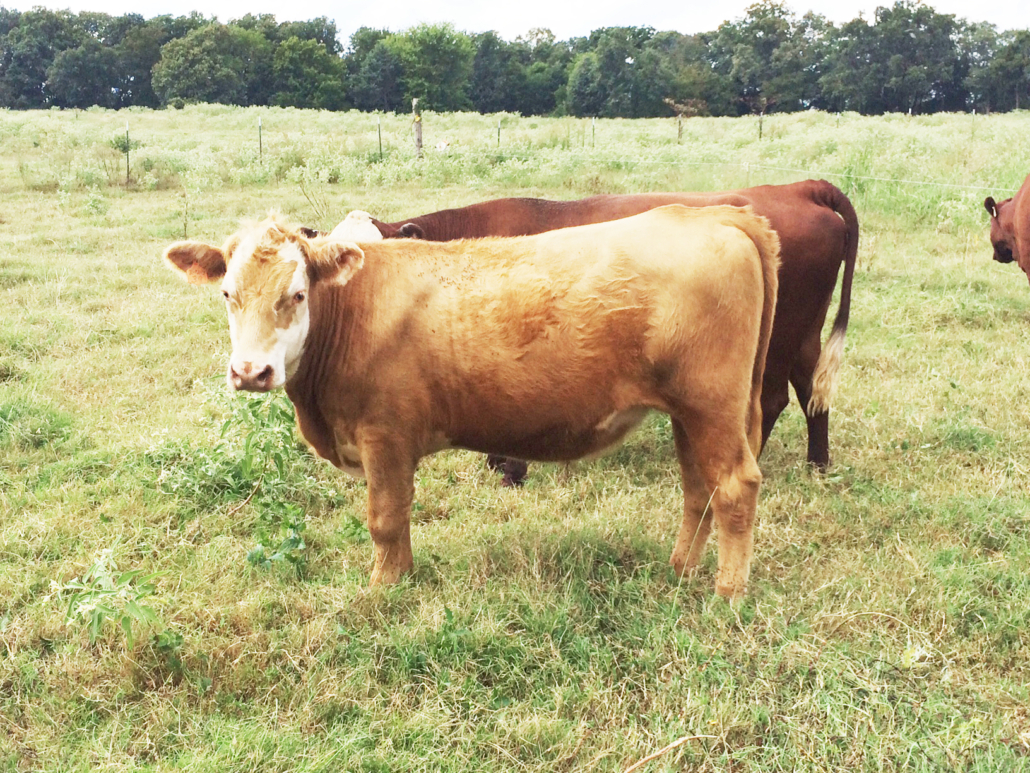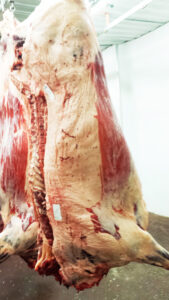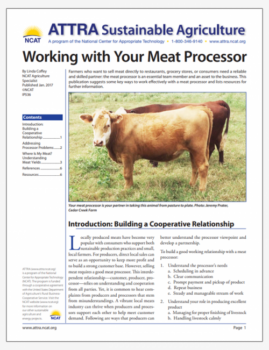Working With Your Meat Processor

Your meat processor is your partner in taking this animal from pasture to plate. Photo: Jeremy Prater,
Cedar Creek Farm
By Linda Coffey, NCAT Agriculture Specialist
Abstract
Farmers who want to sell meat directly to restaurants, grocery stores, or consumers need a reliable and skilled partner: the meat processor is an essential team member and an asset to the business. This publication suggests some key ways to work effectively with a meat processor and lists resources for further information.
Contents
Introduction: Building a Cooperative Relationship
Addressing Processor Problems
Where Is My Meat? Understanding Meat Yields
References
Further Resources
Introduction: Building a Cooperative Relationship
It is important to keep records of how your own animals yield so that with time and experience you can know what to expect.
Locally produced meats have become very popular with consumers who value production practices and want to support small farmers. Producers can benefit from direct local sales as an opportunity to keep more profit and a build strong customer base. However, selling meat requires a good meat processor. This interdependent relationship—customer, producer, processor—relies on understanding and cooperation from all parties. Yet, it is common to hear complaints from producers and processors that stem from misunderstandings. A vibrant local meats industry can thrive when producers and processors support each other to help meet customer demand. Following are ways that producers can better understand the processor viewpoint and develop a partnership.
The Niche Meat Processor Assistance Network (NMPAN) is a network and information hub for people who want small meat processors to thrive. Its website provides a wealth of articles, videos, webinars, and directories that help both processors and the farmers who work with them. Several NMPAN resources relevant to this topic are listed at the end of this publication. Visit the NMPAN site to find many more. The author thanks the members of NMPAN for inspiration, guidance, and material for this publication.
To build a good working relationship with a meat processor:
1. Understand the processor’s needs
a. Scheduling in advance
b. Clear communication
c. Prompt payment and pickup of product
d. Repeat business
e. Steady and manageable stream of work
2. Understand your role in producing excellent product
a. Managing for proper finishing of livestock
b. Handling livestock calmly
c. Providing clear instructions for aging and cutting in a timely manner
3. Have realistic expectations
a. How much meat will this animal yield? Learn about yield factors.
b. How far in advance should I call to schedule? Be aware of seasonality issues.
c. How much should I expect to pay for services?
4. Address all concerns quickly and respectfully
Common courtesy will go a long way toward preventing conflict and understanding the other person’s point of view is crucial. Processors are often the subject of complaint and blame for problems they did not cause. Becoming educated about processor concerns and logistics will help minimize the blaming and maximize the respect in the relationship.
Different Types of Processors
There are different levels of processing, and access to them will affect how you can market your animals.
- Federal- or USDA-Inspected Plants—Federal plants can process meat for nationwide sale.
- State-Inspected Plants—Only about half of the states have a State Inspection Program. State-inspected plants can process any meat, but it is stamped for sale only within that state.
- Custom Exempt Plants—A custom plant processes for individual use. The meat must be stamped “not for sale.”
- Mobile Processing Unit—A truck- or trailer-mounted facility that is transported to the processing site. Some are state or federally inspected. More information is available from eXtension.org.
- On-Farm Slaughter (exempt from inspection)—Animals are processed by the owner for individual use (regulations vary by state).

Cooler space is at a premium. It is very important that customers pick up their meat as soon as possible after it is ready. Photo: NCAT
Addressing Processor Problems
An NMPAN webinar, Working Effectively with your Processor, identified several problems commonly mentioned by producers:
- Scheduling
- Cutting, packaging, or labeling errors
- Order not ready on time
- Low carcass yield
These problems can be alleviated by education and communication. For example:
- Call early for a fall appointment, because it is the busiest time. Also, think about what you can do to produce and finish animals in the off-season: it will be easier for you to get a processing appointment and it is of great benefit to your processor to have steady demand year-round, rather than just during the busy season. Honor your appointments and pick up your meat promptly once it is ready. This cooperation helps the processor with planning and with cooler and freezer space.
- Clearly communicate what you want, and use the cut sheet provided by the processor. Don’t hesitate to ask questions, but plan ahead—call or visit when both you and your processor have time to review the cut sheet (that does not mean when you are standing at the trailer gate, unloading animals!) Keep a copy of the cut sheet for yourself and bring it along when you pick up your order. Make some allowances for human error: give grace as you would want it extended to you.
- If your order is not ready on time, ask why, and then see what the processor can do so that your business is not harmed. If you have been a good, steady, courteous customer, it is likely that the processor will want to make amends when this problem happens. On the other hand, if the processor had an unexpected glitch and unavoidable delay, you may want to be gracious and continue building a positive relationship. In the long run, communication and understanding will pay off best. Also, consider building in more time for processing in the future, so that you do not over-promise to your customers. This can alleviate stress on all parties.
- Low carcass yield is a frequent and serious complaint, and one that really gets producers and processors riled. Understanding what is realistic and what the factors are that impact yield will keep producers calm and avoid insulting the processor’s integrity. See below for more information regarding yields.
Source: NMPAN (Harris and Dunlop, 2011)
Where is My Meat? Understanding Meat Yields
This is possibly the most contentious issue: customers who feel cheated by processors. It is possible that your meat got misplaced in the cooler, and that you really don’t have it all; here is where reviewing your cut sheet may help. But it is more likely that your animal did not yield as well as you hoped.
Live weight = weight on the hoof
Dressed weight = carcass weight = chilled hanging weight
Boxed weight = salable weight=finished weight = meat for the freezer
First, consider the species, type, and condition of the animal you had slaughtered. During slaughter, the hide, head, and guts are removed. On average, the weight remaining after this (carcass weight) as a percentage of live weight is as follows:
61% for beef cattle
59% for dairy steers
72% for hogs
50% for sheep or goats
Meat processor Joe Cloud (2016) notes that there is a range of values and there can be large differences from these averages:
“Grass-fed beef is more like 57%, while fed cattle may be 61%. Dairy steers may be 59%, but cull dairy cows, a common source of ground beef, are 50-51%. Scalded, head-on hogs may be 72%, but many processors skin them and remove the head. That is more like 63%.”
The point is, there is normal variation in dressing percentage. Monitoring your animals for a long time will help you understand what you may expect, on average, for your animals. This is important to know because it impacts pricing.

Dave Scott examines the carcasses of his lambs to check for proper finishing. Photo: NCAT
As the carcass hangs in the cooler, there is additional weight loss, called “shrink.” This is water shed from the muscle tissue as it dries in the cooler. The longer you let it hang in the cooler (“age” the carcass), the more shrink there will be. Having a decent fat cover helps to protect the meat and minimize shrink; very lean carcasses shrink more.
Next, as the butcher cuts the carcass, removing excess fat and bone, the total weight continues to decrease. Animals that are over-finished (too fat) will need to have more fat trimmed, reducing your yield. Your cutting instructions will also impact meat yields. Asking for leaner ground or for boneless cuts will reduce the pounds of product you take home. See the Beef and Pork Whole Animal Buying Guide listed in Further Resources for a full discussion and examples of this topic for beef and pork.
An Example from Montana Highland Lamb:
Live weight X dressing percentage = Dressed weight or chilled hanging weight
Dressed weight X cut out % = Boxed weight or salable meat
Example: lamb live weight= 135 pounds
135 pounds X 50% = Carcass weight = 67 pounds
Carcass weight X cut-out percentage (70%) = Boxed weight = 47 pounds
Your numbers will vary. This is only an example.
A local meat systems consultant from Canada, Abra Brynne, reported on the NMPAN list (2015) the figures in Table 1 for salable meat/species (the percentage of live weight that remains and can be sold), “give or take depending on breed, age, sex, etc.”
| Table 1 | |
| Cattle | 43% |
| Hogs | 47% |
| Sheep | 41% |
| Chickens | 70% |
It is important to track your own animals to learn what you can realistically expect. Dave Scott of Montana Highland Lamb recommends you visit the abattoir after slaughter to examine the carcasses. This lets you better assess your finishing program and will help you learn when to send your animals to slaughter. See Creating an Excellent Relationship with Your Lamb Processor, a 23-minute ATTRA video featuring Dave and his processor.
In his presentation Direct Marketing Your Own Beef, What to Expect!, Dr. Gregg Rentfrow, Extension Meat Specialist at the University of Kentucky, laid out several scenarios that help illustrate the variables affecting yield. For example, see Table 2.
| Table 2. Dressing Percentages for a 1,200-pound Beef Animal | |
| Grain fed | 60-62% |
| Forage finished | 5-58% (Gut fill and leanness impact these figures.) |
Suppose you have two identical animals, but different cutting instructions (Table 3).
| Table 3 | |
| Cut Instructions | Pounds of Meat |
| Boneless steaks and roasts | 425 |
| 1/8” trim | |
| 90/10 ground beef | |
| Bone-in steaks and roasts | 500 |
| ¼” trim | |
| 80/20 ground beef | |
That is a pretty dramatic difference, and it is the producer’s instructions that caused it.
Yield can also vary due to the animal characteristics (see Table 4).
| Table 4 | ||
| Animal | Cut Instructions | Pounds of Meat |
| 1,200-pound Holstein | Boneless steaks and roasts | 390 |
| 1/8” trim | ||
| 90/10 ground beef | ||
| Very fat 1,200-pound beef | boneless steaks and roasts | 340 (because excess fat had to be discarded) |
| 1/8” trim | ||
| 90/10 ground beef | ||
You can see that if you first had an average 1,200-pound beef and asked for bone-in, 80/20, and next time processed an over-fat 1,200-pound beef and asked for boneless cuts and leaner ground, the difference in yield might have you questioning the integrity of the processor.
These examples are given to illustrate the point, and are NOT necessarily numbers you can use for your farm. It is important to keep records of how your own animals yield so that with time and experience you can know what to expect.
Dave Scott of Montana Highland Lamb has found that, “You can lose 20% of a leg cut by making it into kabobs vs. a leg roast. Some of this you get back in the trim, but at a lower price point. It all depends on your animal and how you want it cut. Many producers don’t realize this because they likely have not had a chance to closely monitor their carcasses”
(Scott, 2016).
For more information about meat yields and cuts, in a very user-friendly format, consult the Beef and Pork Whole Animal Buying Guide, published by the Small Meat Processors Working Group at Iowa State University. It is valuable for your own education and for giving to your customers.

It takes a skilled and knowledgeable crew to convert live animals into cuts that are ready for the chef or the family cook. Build a positive relationship with these essential partners. Photo: NCAT
Dr. Duane Wulf, of South Dakota State University, provides another resource that briefly explains differences in dressing and cut-out percentages, with examples for beef, pork, and lamb here.
A very concise and clear look at this question of meat yields is available in a one-page document from Pennsylvania State University.
You and your meat processor together make it possible to sell the meat you produce. Make your partnership stronger by understanding the needs of the processor, doing what you can to make the processing job easier and more successful, and respecting the work and integrity of the meat processor. Knowing what is reasonable can give you peace of mind and help you stay on good terms with this essential partner.
“I suggest that farmers ask to spend an hour or two, or even a day, wearing a butcher smock and hanging out watching the butchers work. I love it when my farmers do this. They learn the cuts, they learn about carcass qualitative differences, and perhaps most importantly, they learn about my guys. That means when a mistake is made, it isn’t ‘Those [expletive] at T&E screwed me over again’, it’s more like, ‘Oh, darn, Danny made a mistake. He’s a nice guy, I’m sure he didn’t mean to. I’ll have to talk to him about it.'”
― Joe Cloud, T&E Processing (2016)
References
Brynne, Abra. 2015. Online posting. NMPAN listserv. December 1.
Cloud, Joe. T&E Processing. Personal communication with author, 2016.
Harris, Kathleen, and Bruce Dunlop. 2011.Working Effectively with your Processor. eXtension, NMPAN Webinars.
Rentfrow, Gregg. No date. Direct Marketing Your Own Beef: What to Expect. University of Kentucky.
Scott, Dave. 2016. Montana Highland Lamb. Personal communication with author.
Thiboumery, Arion and Kristine Jepsen. 2009. Beef and Pork Whole Animal Meat Buying Guide. Iowa State University. PM 2076.
Further Resources
Organizations
Niche Meat Processor Assistance Network
NMPAN is a network and info hub for people and organizations who want small meat processors to thrive. This site is a place to find tools and information for small processors and the farmers, marketers, and meat buyers who depend on them.
Beginner’s Guide to Local Meat Processing. 2016. By Lauren Gwin and Rebecca Thistlethwaite.
Working Effectively with your Processor. 2011. By Kathleen Harris and Bruce Dunlop. eXtension, NMPAN Webinars.
Articles about research done by NMPAN and others can be found here. Titles include the following:
The Economics of Local Meat Processing. 2014. By L. Gwin and K. Quanbeck. AgMag. Fall Issue.
Local Meat and Poultry Processing: The Importance of Business Commitments for Long-Term Viability. 2013. By L. Gwin, A. Thiboumery, and R. Stillman. Economic Research Report 150, U.S. Department of Agriculture, Washington D.C.
Slaughter and Processing Options and Issues for Locally Sourced Meat. 2012. By R. Johnson, D. Marti, and L. Gwin. Market Outlook Report, Economic Research Service, U.S. Department of Agriculture, Washington D.C.
ATTRA Sustainable Agriculture Program, National Center for Appropriate Technology
ATTRA is a program managed by the National Center for Appropriate Technology (NCAT). From its website you may access over 400 publications and numerous videos, online courses, and webinars. You will also find helpful databases, including one that lists small poultry processors, and a calculator for cut yield for lambs. Useful resources include:
Creating an Excellent Relationship with Your Lamb Processor. 2014. By Dave Scott. National Center for Appropriate Technology.
Putting a Hand on Them—How to Tell When Your Lamb is Finished. 2014. By Dave Scott. National Center for Appropriate Technology.
Other Resources
Beef and Pork Whole Animal Meat Buying Guide. 2009. By Arion Thiboumery and Kristine Jepsen. 2009. Iowa State University. PM 2076.
Meat Cut Yield: Did the Butcher Keep Your Meat? No date. By Christopher R. Raines. Pennsylvania State University.
Direct Marketing Meat from Your Farm. No date. By Gregg Rentfrow. University of Kentucky.
Meat Marketing Planner: Strategic Marketing for Farm-to-Table Meat Enterprises. 2013. By Ginger S. Myers. University of Maryland Extension. Bulletin EB-403.
The New Livestock Farmer: The Business of Raising and Selling Ethical Meat. 2015. By Rebecca Thistlethwaite and Jim Dunlop. Chelsea Green Publishing. White River Junction, Vermont.
A chapter of this extensive and practical book is dedicated to slaughtering and butchering logistics. Much detail about choosing a processor, preparing for slaughter, and working with your processor is provided. Information about typical dressing percentages and cutting yields is given. The entire book is highly useful if you intend to raise livestock for meat sales.
Working With Your Meat Processor
Published January 2017
By Linda Coffey, NCAT Agriculture Specialist
©NCAT
IP536
Slot 558
Version 011117
This publication is produced by the National Center for Appropriate Technology through the ATTRA Sustainable Agriculture program, under a cooperative agreement with USDA Rural Development. ATTRA.NCAT.ORG.


